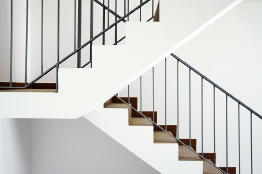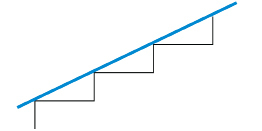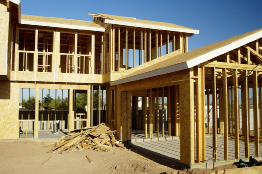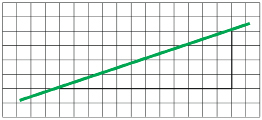Module 5
1. Module 5
1.9. Page 4
Bringing Ideas Together
In Getting Started and Explore, you examined what it means to say that two or more angles are congruent. You saw that there are congruent angles all around you—in building design, in art, and in nature. Also, in Explore, you formed congruent angles through paper folding.
straightedge: a rigid strip of wood, metal, or plastic having a straight edge used for drawing lines
When a ruler is used without reference to its measuring scale, it is considered to be a straightedge.
In the next activity you will construct congruent angles using another approach—one that geometers have used for thousands of years. You will use your compass and a straightedge to draw congruent angles. Only after you are done will you use your protractor to measure the angles to check the accuracy of your construction.
But before you begin, review how to identify angles.

If an angle stands alone as ∠ABC does, you may use a single letter to name it. ∠ABC and ∠B are the same angle. Notice that when a three-letter name is used, the middle letter is always the vertex. Likewise, the vertex is the only letter you can use for a single-letter name.
When there are two or more angles at a point, as when ![]() intersects
intersects ![]() at point X, confusion is possible. To distinguish among the angles, you must use a three-letter name or number the angles.
at point X, confusion is possible. To distinguish among the angles, you must use a three-letter name or number the angles.
So at the intersection of the lines, ∠PXS is ∠1 and ∠QXS is ∠2.
Now use your compass and a straightedge to construct an angle congruent to ∠A.

Step 1: Draw a ![]() This will be the lower arm of the new angle. Notice that it does not have to point in the same direction as the lower arm of ∠A.
This will be the lower arm of the new angle. Notice that it does not have to point in the same direction as the lower arm of ∠A.

Step 2: Use your compass to draw circles with the same radius centred at A and at B.
The first circle cuts through the arms of ∠A at P and Q. The second circle cuts across ![]() at X.
at X.

Step 3: With centre Q, draw a circle through P. With centre X and the same radius, draw a similar circle cutting the circle you drew in Step 2 at Y.

Step 4: Draw ![]() Use your protractor to check that
Use your protractor to check that ![]()

Go to the applet “Constructing Congruent Angles” to view the construction of congruent angles demonstrating a compass and straightedge construction.
 Self-Check
Self-Check
SC 1. Draw any obtuse angle. Then, with a compass and a straightedge, follow the steps you were just given to construct a second angle congruent to the obtuse angle. Then use a protractor to check whether your second angle is actually congruent to the first.
Stairs and Roofs

© Mrfotos/shutterstock
In construction, carpenters use their carpenter squares to measure horizontally and vertically to obtain the angle required for projects such as stairs or roofs.
Think of a set of stairs.
The angle of the stairs does not change. Can you suggest a reason why?

This uniformity guarantees that the angles are the same from step to step. You could lay a straight board on the steps to check. The board would rest on all the step edges.
The ratio of the riser height to the tread length affects the steepness or angle of the stairway. In other words, the vertical and horizontal measurements of a stairway affect its angle. Also for a roof, vertical and horizontal distances affect the angle of the roof.
The following is an example of how the slope of a roof can be determined from vertical and horizontal distances.
Example 1
 © Jim Parkin/Fotolia.com
© Jim Parkin/Fotolia.com
Akiko and her father are building a house and an attached garage. The slope of the garage roof is a 4-in rise for every 12 in measured horizontally.
- Draw a diagram of the roof using quarter-inch grid paper.
You will need one sheet for the example and another sheet for the Self-Check.
- Measure the angle at which the roof rises.
Solution
Use one square to represent one inch.

- Use your protractor to measure the angle.
The angle of the roof is approximately 18.5°.
 Self-Check
Self-Check
SC 2. For a roof that slopes at 45°, what is the rise (in inches) for a horizontal run of 12 in?
SC 3. Use grid paper to determine the angle at which a ladder rests against a vertical wall. The foot of the ladder is 3 ft from the wall, and the top of the ladder rests against the wall 8 ft above the ground.
 Mastering Concepts
Mastering Concepts
Try this question. To do this question you will need your protractor. When you are finished, check your answer.
Compare the following angles.

Which of the following statements best describes the relationship between ∠A and ∠B?
- ∠A is smaller than ∠B.
- ∠A is congruent to ∠B.
- ∠A is larger than ∠B.
Justify your answer.



